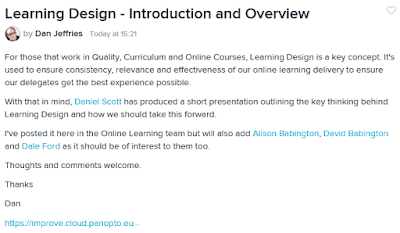Not long after I started my new job in January 2017, I asked out to the ALT community about designing for higher education distance learning. As I recently started my new job, I wanted to refresh myself on the whole development process and the ways that people and organisations approach this. I was interested to know the processes that they undertook when planning, designing and delivering their distance learning programmes.
I then thought it's a bit like writing a song; which comes first, the lyrics or the melody? Which one do you start with first? Attack the melody and lace with lyrics, or write the lyrics and wrap the music around the words? I was trying to remind myself of a process I can easily follow and get into a routine with. As there are lots of inspiring models, cycles and processes you can follow - which always appeal to me. However, I struggled to find which one was suitable to my simplistic mind set and which I could jump straight into without reading too much into it. This thinking then evolved into higher-level learning design (LD). LD has fast become an area I want to specialise in, which I introduced previously at the end of this post. I am keen to introduce LD into my new organisation as it would be extremely useful to us, especially being a fast-paced commercial organisation. I decided to understand what LD is first then produce a brief report of how it impacts on my new organisation.
Investigating and making sense of learning design
I began investigating LD by sourcing good practice done by The Open University and then came across a wealth of information by them and the learning design community. However, I thought it was best to contact someone who is currently doing lots of work in this area; Sheila MacNeill who kindly responded to my questions below (off the top of my head) and briefly analysed and interpreted her responses into my own understanding using track changes in Microsoft Word.
- What typical project(s) and the processes you undergo?
- What theoretical and digital approaches do you use for LD?
- Where and how do you enter a LD cycle/process?
- Do learners get involved?
- Are learning analytics used?
- Do you have focus groups with both staff and learners to collect feedback and conduct evaluation?
- How do you implement feedback?
The main thing I want to report back to my team is:
- How does LD relate to and impact on our post/undergraduate and subscription CPD courses?
Framing my understanding of learning design
To consolidate my understanding I collected good practice from my research and ideas from the questions I asked Sheila. Instead of writing up a dull report, I turned the information into something meaningful and relatable to my organisation through a presentation (below), which I then delivered to curriculum and quality members in my organisation. I can say that it was well received and the process of implementing it has begun.
The recording of me delivering the presentation which I sent out to colleagues:


